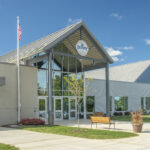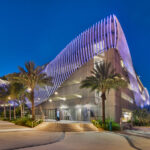 Chicago is well known for its many historic sites, political tales and sightseeing adventures. But the city’s unique allure may be broadened as the home to one of the seven wonders of U.S. engineering. In 1955, the American Society of Civil Engineers made this claim about the reversal of the flow of the Chicago River. The river, which used to empty into Lake Michigan, was reversed in 1900 with a series of canal locks. This reverse was needed to control pollution that emptied into the lake, as well as help with navigation.
Chicago is well known for its many historic sites, political tales and sightseeing adventures. But the city’s unique allure may be broadened as the home to one of the seven wonders of U.S. engineering. In 1955, the American Society of Civil Engineers made this claim about the reversal of the flow of the Chicago River. The river, which used to empty into Lake Michigan, was reversed in 1900 with a series of canal locks. This reverse was needed to control pollution that emptied into the lake, as well as help with navigation.
The Chicago Harbor Lock, located at the mouth of Lake Michigan on the Chicago River, was built in 1938. It is the second busiest lock and only lock in the United States controlled by gravity, not pumps, to shift water levels to and from the higher Lake Michigan to the lower Chicago River.
The lock, operated and owned by the U.S. Army Corps of Engineers, can be navigated 24 hours per day, seven days a week. The lock sees about 40,000 commercial and recreational boats a year, requiring the locks themselves to open about 17,000 times.
The U.S. Army Corps of Engineers has commissioned a phased renovation of the locks and lock facilities. Phase one was building a new control house to create a control operation facility, as well as office, maintenance and storage spaces.
The $5.5 million building, which opened in October 2007, may become another wonder in Chicago because of its shape and design. Architects at CTE AECOM, Chicago, designed the facility to resemble a ship. The design obviously was inspired by the facility’s nautical purpose and environment, and using zinc panels helped create the ship look. The ship-like building also was a creative way to construct on a 40-foot- (12-m-) wide site.
Design Awards judge Ron McKenzie added: “A very creative building solution for the Chicago Harbor Lock located on Lake Michigan that was inspired by the nautical environment. Using RHEINZINK Titanium Zinc with a preweathered finish, the complex geometry of a ship was mimicked.”
The original lock and its facilities have historic status. But because the previous structures have no consistent architectural style,CTE AECOM was not required to create a building that would blend with existing structures.
 Functionality of the control house was vita to operating the locks. The control operation facility takes up the entire second floor and glass tower. This provides a 270-degree view of the harbor. In addition, the tower is tilted and the desks are glass so engineers have an open view of the locks below.
Functionality of the control house was vita to operating the locks. The control operation facility takes up the entire second floor and glass tower. This provides a 270-degree view of the harbor. In addition, the tower is tilted and the desks are glass so engineers have an open view of the locks below.
The control house features 9,000 square feet (836 m2) of 0.16-inch
(4-mm) Reynobond Zinc Composite Material from Alcoa Architectural Products, Eastman, Ga. The material has a FR Core with a skin thickness of 0.03 inch (0.7 mm) and skin alloy of RHEINZINK Titanium Zinc with a preweathered finish. The RHEIZINK material is from RHEINZINK America Inc., Cambridge, Mass.
Reynobond ZCM panels were used on the southern and eastern elevations of the lower building, all elevations and soffit of the tower, and interior column enclosures. Reynobond Brushed Aluminum Composite Material was used to fabricate interior window stools.
Although the design creatively depicts the building’s purpose, the construction was challenging. “It was a complex installation,” said Craig Heaney of Shaffner Heaney Associates, South Bend, Ind. The company engineered and fabricated the metal panels on the building. “We were faced with the difficult challenge of mimicking the complex geometry of a ship. Enhancing the complexity was that the only wall structure provided was a concrete shear wall. All of the panels and glass walls are supported on hundreds of unique framing members much like ribs on a ship.” The panels were attached to the shear wall to create the geometry of the ship’s bow, sides and stern.
Metal was chosen for its aesthetics, reflecting the nautical theme and look of a ship; practicality; and sustainable natures of zinc. “Zinc is one of the most environmentally friendly materials available,” said Melita Ristovska of CTE AECOM. “It also becomes more beautiful as it ages. In this case, I believe the patina will develop a bluish color reflecting the natural environment of the locks and that as it ages and the patina deepens, it will meld beautifully with the historic structures on the site.”
Design Awards judge Bruce Lynch couldn’t agree more. He said: “The choice of metal adds a wonderful consistency to the greater environment and ensures fl ow between the structure and the waterway. Economical attributes of zinc make this a solid choice for a public project.”
 Control House at Chicago Harbor Lock, Chicago
Control House at Chicago Harbor Lock, Chicago
Architect: CTE AECOM, Chicago, www.cte.aecom.com
General contractor: Schaefges Brothers Inc., Wheeling, Ill., www.sbigc.com
Metal fabricator: Shaffner Heaney Associates, South Bend, Ind., www.shaffnerheaney.com
Metal installer: BBC, Bensenville, Ill.
Building owner: U.S. Army Corp. of Engineers
Metal panels: Alcoa Architectural Products, Eastman, Ga., www.alcoa.com
Metal skin alloy: RHEINZINK America Inc., Cambridge, Mass., www.rheinzink.com






